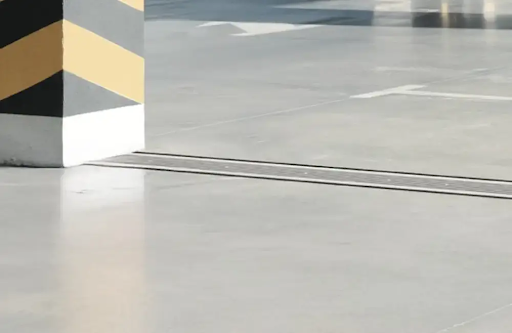Ceiling Expansion Joint: Function, Materials, and Best Practice

Ceiling expansion joints are essential in building design, especially when working with large or multi-structure buildings.
The joints absorb and accommodate structural movement caused by thermal shifts, seismic activity or building settlement.
If installed correctly, they can prevent costly damage like cracks, warping or even full ceiling failure, making them a key component that can literally make or break your designs.
The Function of Ceiling Expansion Joints
In a nutshell, ceiling expansion joints are engineered gaps in a ceiling system. They help maintain the alignment and structural integrity of a building by:
Allowing for Movement
Expansion joints support buildings as they settle, shift and respond to environmental conditions like:
- Temperature Changes: Thermal expansion and contraction can cause building materials to expand during heat and contract when temperatures drop.
- Humidity: Fluctuations in humidity levels can cause ceiling components to swell or shrink.
- Settling: Differential settling between parts of a structure can create stress across ceiling planes.
- Seismic Activity: Seismic regions are constantly moving, even when we can’t feel it.
Expansion joints act as intentional “break points” that absorb building movement. They mitigate these forces by allowing movement between ceiling sections or between ceilings and adjoining walls.
To prevent movement-related failures, expansion joints should be utilized. They reduce the need for repairs and keep the building in line with building codes and performance standards.
Maintaining Alignment and Integrity
Expansion joints play a crucial role in maintaining the alignment and strength of ceiling and wall systems as the building envelope responds to internal and external forces.
Without expansion joints, the stresses caused by thermal expansion, contraction or structural movement can create visible cracks, joint separation or warping across ceiling panels and wall connections.
Expansion joints prevent stress from transferring across rigid materials and disrupting the structural integrity of the building.
Materials Used in Ceiling Expansion Joints
The materials used in expansion joints are chosen specifically for the gap size, durability needs and flexibility requirements.
Types of Materials for Different Applications
The best type of expansion joints for a particular building will depend on the size of the building, as well as location and climate.
Seal-Type Expansion Joints
These are generally chosen for smaller ceiling joints or regions that don’t experience a lot of natural or seismic movement.
They’re made from elastomeric materials like rubber, silicone or thermoplastic and can compress and expand as needed. They also present a clean, low-profile appearance that integrates well with ceiling finishes.
Metal Expansion Joints
These expansion joints are generally best for buildings with larger joint openings or those that require greater durability and load resistance. These include high-traffic corridors, large-span structures or buildings in seismic zones.
Metal expansion joint covers are typically made from aluminum or stainless steel. These provide protection while allowing for multidirectional movement.
Aesthetic Considerations
Visual appeal also plays a big part when choosing expansion joints and covers for a ceiling.
In high-visibility areas where aesthetics matter, selecting expansion joints that blend seamlessly into the ceiling or walls is an important part of the design.
Aluminum and steel expansion joints and covers can be powder-coated or field-painted to match or complement the building’s other surfaces.
Seal-type joint systems made from elastomeric materials are less noticeable and are usually color-matched or concealed behind trim elements.
Best Practices for Expansion Joint Installation
By properly planning for expansion joints and following installation best practices, you can increase the durability and performance of the joints. This helps prevent the need for maintenance, repairs or replacement later on.
Professional Installation
Contractors who have worked with ceiling expansion joints before can usually tackle the installation on their own.
However, contractors who lack experience with expansion joints or want more guidance can get expert help by partnering with a supportive manufacturer.
Key Installation Considerations
The correct ceiling expansion joint size depends on the expected movement of the structure. Aside from climate and seismic activity, considerations like building length and material composition are important.
As a general rule of thumb, longer spans and more dynamic environments require wider joints. Undersized joints are a common cause of ceiling cracks and misalignment. That’s why architects must review structural movement data and manufacturer guidelines early in the design process.
When selecting the right material for expansion joints, environmental exposure is also a key consideration. For example, in humid environments, non-corrosive materials like coated aluminum or stainless steel are the best choice.
Placement is equally important. Expansion joints should be located at logical structural breaks, including:
- Between separate structural bays
- Where building wings meet
- At wall-to-ceiling intersections
Proper alignment of expansion joints is essential for both function and finish. Misaligned or loosely installed components can impair movement or create visible defects in the ceiling.
Coordination with other trades, including HVAC, lighting and ceiling grid installation, helps avoid conflicts and ensures a clean, functional result.
Maintenance of Expansion Joints
Expansion joints don’t require much maintenance, but routine cleaning and inspections can extend the life of the expansion joint and prevent expensive repairs or replacements.
Regular Inspections and Upkeep
Even though properly installed expansion joints are designed to flex and move with the structure, they can still develop damage from stress and movement over time.
Regular inspections help identify early signs of degradation or misalignment before they escalate into visible ceiling cracks, joint separation or compromised finishes.
In high-traffic buildings like hospitals, schools and large commercial facilities, expansion joints should have routine inspections performed at regular intervals.
When inspecting ceiling expansion joints, contractors should watch for key indicators of wear or improper function. These include:
- Material Degradation: Look for cracking, hardening or tearing in elastomeric seals, and check metal covers for corrosion, dents or loose fasteners.
- Misalignment: Ensure the joint remains properly aligned with structural breaks and that covers or seals haven’t shifted from movement or installation errors.
- Restricted Movement: Check that the joint allows for the intended expansion and contraction. Obstructions, debris or over-painted surfaces can limit flexibility.
- Water or Moisture Damage: Inspect for signs of water intrusion, staining or mold, particularly in areas near HVAC systems or roof transitions.
- Finish Deterioration: In finished ceilings, look for sagging, cracking or visual separation around the joint, which can indicate failure underneath.
Follow your inspection with a simple cleaning. Exposed surfaces can be wiped down with a sponge or soft cloth and a mild water-based cleaning solution.
With routine inspections and maintenance, expansion joints should continue to perform for many years to come.
Repairing and Replacing Expansion Joints
If ceiling expansion joints show signs of damage, wear or functional failure during an inspection, repairs or replacement should be organized immediately.
Minor issues like surface wear on metallic covers or cosmetic cracking in seal-type joints can usually be fixed easily with light repairs or component replacement. But, if the joint no longer accommodates movement as designed because of hardened seals, broken fasteners or visible displacement, the expansion joint must be replaced.
When replacing an expansion joint, follow manufacturer guidelines closely to ensure compatibility with the existing ceiling system and expected movement tolerances.
Contractors who need help with repairs or replacement should reach out to their manufacturing partner to get expert advice.
Partner With The Professionals At Nystrom
When it comes to relying on a ceiling expansion joint manufacturer who puts customers first, look no further than Nystrom.
We are here to not only provide you with high-quality building solutions, but we are available to help you with installation tips, replacement advice and more. Our products are backed by professionals who can support you every step of the way.
To find the right ceiling expansion joint for your job or to get expert insights on project specifics, our team at Nystrom is just a phone call away.
Contact us today, and we will help take your expansion joint projects to the next level.




